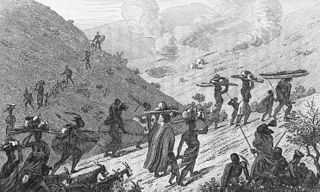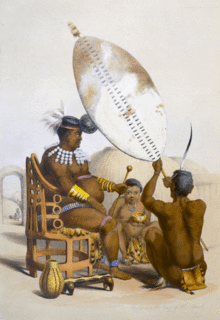
Eswatini, officially the Kingdom of Eswatini and also known as Swaziland, is a landlocked country in Southern Africa. It is bordered by Mozambique to its northeast and South Africa to its north, west and south. At no more than 200 kilometres (120 mi) north to south and 130 kilometres (81 mi) east to west, Eswatini is one of the smallest countries in Africa; despite this, its climate and topography are diverse, ranging from a cool and mountainous highveld to a hot and dry lowveld.

Artifacts indicating human activity dating back to the early Stone Age have been found in the Kingdom of Eswatini. Prehistoric rock art paintings date from c. 25,000 B.C. and continuing up to the 19th century can be found in various places around the country.

Mfecane, also known by the Sesotho name Difaqane or Lifaqane, was a period of widespread chaos and warfare among indigenous ethnic communities in southern Africa during the period between 1815 and about 1840.

The Swazi, Swati or siSwati language is a Bantu language of the Nguni group spoken in the Kingdom of eSwatini and South Africa by the Swazi people. The number of speakers is estimated to be in the region of 12 million. The language is taught in eSwatini and some South African schools in Mpumalanga, particularly former KaNgwane areas. Swazi is an official language of eSwatini, and is also one of the eleven official languages of South Africa.
The Nguni languages are a group of Bantu languages spoken in southern Africa by the Nguni people. Nguni languages include Xhosa, Zulu, Ndebele, Swati, Hlubi, Phuthi, Bhaca, Lala, Nhlangwini, Southern Transvaal Ndebele, and Sumayela Ndebele. The appellation "Nguni" derives from the Nguni cattle type. Ngoni is an older, or a shifted, variant.

Mpande (1798–1872) was monarch of the Zulu Kingdom from 1840 to 1872, making him the longest reigning Zulu king. He was a half-brother of Sigujana, Shaka and Dingane, who preceded him as kings of the Zulu. He came to power after overthrowing Dingane in 1840.

Goodwill Zwelithini kaBhekuzulu is the reigning King of the Zulu nation under the Traditional Leadership clause of South Africa's republican constitution.

The Swazi or Swati are a Bantu ethnic group of Southern Africa, predominantly inhabiting modern Eswatini and South Africa's Mpumalanga province. The Swati are part of the Nguni family that can be archaeologically traced in East Africa where the same tradition, beliefs and cultural practices are found. The Swati share a unique experience, culture and Royal lineage. This lineage is exclusive to the inhabitants of Eswatini, even though there have been more Swazi people that have moved to South Africa and the United Kingdom in the 20th century. The original inhabitants of Eswatini no longer reside in Eswatini as a majority population while some remain in the land. The Swazi people and the Kingdom of Eswatini today are named after Mswati II, who became king in 1839 after the death of his father King Sobhuza who strategically defeated the British who occupied Swaziland. The Kingdom of Swaziland was a region occupied by the San people of Southern Africa and the current Swazis came in from North Eastern regions through to Mozambique and eventually Swaziland in the 15th century. Mixtures with the San people and other Nguni tribes occurred. Their royal lineage can be traced to a chief named Dlamini I; this is still the royal clan name. About three-quarters of the clan groups are Nguni; the remainder are Sotho, Tsonga, others North East African and San descendants. These groups have intermarried freely. There are slight differences among Swazis as a nation with varying features and skin tones yet Swazi identity extends to all those with allegiance to the twin monarchs Ingwenyama "the Lion" and Indlovukati "the She-Elephant". The dominant Swati language and culture are factors that unify Swazis as a nation since there is no other language spoken except for English.

Sobhuza II, KBE was the Paramount Chief and later King of Swaziland for 82 years and 254 days, the longest verifiable reign of any monarch in recorded history. Sobhuza was born on 22 July 1899 at Zombodze Royal Residence, the son of Inkhosikati Lomawa Ndwandwe and King Ngwane V. When he was only four months old, his father died suddenly while dancing incwala. Sobhuza was chosen king soon after that and his grandmother Labotsibeni and his uncle Prince Malunge led the Swazi nation until his maturity in 1921. Sobhuza led Swaziland through independence until his death in 1982. He was succeeded by Mswati III, his young son with Inkhosikati Ntfombi Tfwala, who was crowned in 1986.

KaNgwane was a bantustan in South Africa, intended by the apartheid government to be a semi-independent homeland for the Swazi people. It was called the "Swazi Territory" before it was granted nominal self-rule in 1981. Its capital was at Louieville. It was the least populous of the ten homelands, with an estimated 183,000 inhabitants. Unlike the other homelands in South Africa, KaNgwane did not adopt a distinctive flag of its own but flew the national flag of South Africa.
In Nguni legend, Mnguni was the founder of the Nguni nation in southern Africa. Zulu are a sub nation in the Nguni nation. Mnguni's name derives from the word Nguni, the name for the majority ethnicity in South Africa. It includes the Zulu, Swazis, Ndebeles, and Xhosas, among others. Most of the different Nguni nations trace their lineage to Mnguni, the king of the unified Nguni nation in South Africa. He is said to have come from the northeast about 1000 years ago.
Black people from South Africa were at times officially called Bantu by the apartheid regime. The term Bantu is derived from the word for "people" common to many of the Bantu languages. The Oxford Dictionary of South African English describes its contemporary usage in a racial context as "obsolescent and offensive" because of its strong association with white minority rule and the apartheid system. However, Bantu is used without pejorative connotations in other parts of Africa.
Mbandzeni (1855–1889) was the King of Swaziland from 1875 until 1889. Ingwenyama Mbandzeni was the son of Mswati II and Nandzi Nkambule. His mother the wife of King Mswati had died when he was still very young. Mbandzeni ascended to the throne after his half brother Ludvonga II died before he could become the king. Ludvonga's death resulted in his mother Inkhosikati Lamgangeni adopting Mbandzeni who was motherless as her son, thus making him King and her the Queen mother of Swaziland. His royal capital was at Mbekelweni. During his kingship Mbandzeni, granted many mining, farming, trading and administrative concessions to white settlers from Britain and the Transvaal. These concessions granted with the help of Offy Sherpstone eventually led to the conventions of 1884 and 1894, which reduced the overall borders of Swaziland and later made Swaziland a protectorate of the South African Republic. During a period of concessions preceded by famine around 1877 some of the tindvunas (governors) from within Swaziland like Mshiza Maseko and Ntengu kaGama Mbokane were given permission by King Mbandzeni to relocate to farms towards the Komati River, Mshiza Maseko later settled in a place called eLuvalweni, where he was later buried. Mbandzeni, still in command of a large Swazi army of more than 15000 men aided the British in defeating Sekhukhune in 1879 and preventing Zulu incursion into the Transvaal during the same year. As a result, he guaranteed his country's independence and international recognition despite the Scramble for Africa which was taking place at the time. Mbandzeni died after an illness in 1889 and is quoted to have said in his deathbed "the Swazi kingship dies with me". He was buried at the royal cemetery at Mbilaneni alongside his father and grandfather Sobhuza I. Mbandzeni was succeeded by his young son Mahlokohla and his wife Queen Labotsibeni Mdluli after a 5 year regency of Queen Tibati Nkambule. Today a number of buildings and roads in Swaziland are named after Mbandzeni. Among these the Mbandzeni house in Mbabane and the Mbandzeni Highway to Siteki are named after him.

Klein Vrystaat was a short-lived Boer republic in what is now South Africa.

Nada the Lily is an historical novel by English writer H. Rider Haggard, published in 1892. It is said to be inspired by Haggard's time in South Africa (1875–82). It was illustrated by Charles H. M. Kerr.
Eswatini is home to several languages. Native languages are Swazi, Zulu, Tsonga, Afrikaans, and English. Recent immigrant languages include Chichewa and Southern Sotho.
Bhaca (Baca) is a Bantu language of South Africa. Traditionally considered a dialect of Swati, it is closer to Zulu, Phuthi and Xhosa. It is spoken southeast of Lesotho, where Sotho, Xhosa and Zulu meet, mainly around Mount Frere, Mzimkhulu, and to a lesser extent in Mount Ayliff, Matatiele, Harding, Bulwer, Underberg, Highflats, Umzinto, Umzumbe and Ixopo.
Nhlangwini (Hlangwane) is a Bantu language of South Africa. It is located along the border between Xhosa and Zulu, but is more closely related to Swazi.
Several braille alphabets are used in South Africa. For English, Unified English Braille has been adopted. Nine other languages have been written in braille: Afrikaans, Ndebele, Sesotho, Northern Sotho, Swazi, Tswana, Venda, Xhosa, and Zulu. All print alphabets are restricted to the basic Latin alphabet, with diacritics in some cases; the braille alphabets are likewise basic braille with additional letters to render the diacritics.
A traditional Swazi wedding ceremony is called untsimba, where the bride commits herself to her new family for the rest of her life. The ceremony is a celebration that includes members of both the bride's - and the groom's - natal village. There are stages to the wedding that stretch over a few days. Each stage is significant, comprising symbolic gestures that have been passed on from generation to generation. The first stage is the preparation of the bridal party before leaving their village. The second stage is the actual journey of the bridal party from their village to the groom's village. The third stage is the first day of the wedding ceremony that spans three days, and starts on the day the bridal party arrives at the grooms’ village. Thereafter the actual wedding ceremony takes place which is the fourth stage of the umtsimba. The fifth stage takes place the day after the wedding ceremony and is known as kuteka, which is the actual wedding. The final stage may take place the day after the wedding day, and is when the bride gives the groom's family gifts and is the first evening the bride spends with the groom. Although the traditional wedding ceremony has evolved in modern times, the details below are based on historic accounts of anthropologist Hilda Kuper and sociological research describing the tradition










